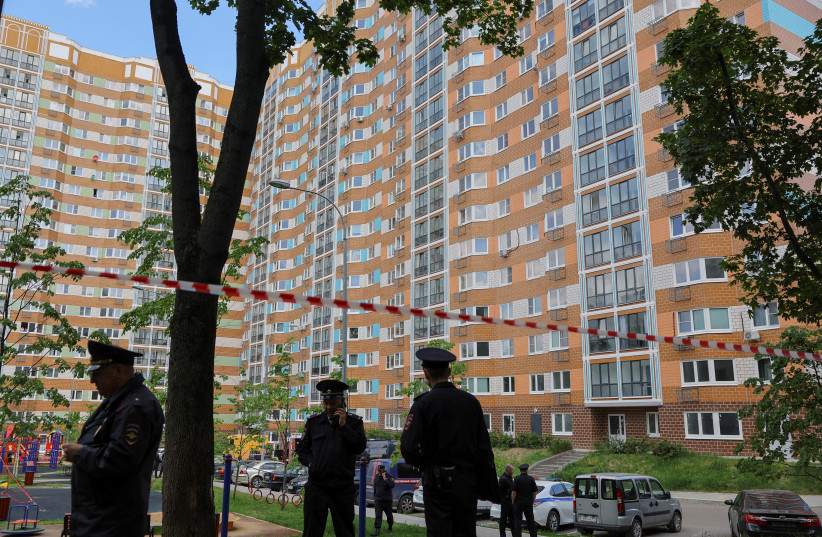Moscow was targeted by drones on Tuesday morning, an offensive move by Ukraine that came after weeks of intensive attacks on Kyiv by Russian drones. In these attacks, Russia used more than 300 Iranian-designed Shahed drones.
The drone wars unfolding over the skies of Ukraine and Moscow – situated at a distance of more than 1,000km. from each other – shows how drones are, and will be, the go-to weapon for use in complex warfare.
According to Russian state TASS media, Russia has said that “Moscow and the Moscow Region were attacked by drones... Several buildings sustained minor damage, Moscow Mayor Sergey Sobyanin said. According to the authorities, there were no casualties and emergency services are continuing to work at the scene.”
Russia forced to admit its drone vulnerability
Moscow has had to admit it is vulnerable now – to Kyiv’s drones: “Fire and rescue units arrived at the scene. According to eyewitnesses, explosions were heard at the time of the incident… Emergency services told TASS that drone-like fragments were found around the house. The windows of apartments on three floors were shattered.”
The Kyiv Post reported that “Moscow was targeted by a drone attack causing ‘minor’ damage to several buildings but no casualties, according to the city’s mayor.” Moscow region governor Andrei Vorobyov was quoted as claiming several were intercepted. Russia has used more than 300 drones, according to data gathered from Ukrainian Air Force reports, to attack Ukraine. They are mostly of the delta-wing Shahed 136 type.
On Monday, Ukraine’s air force said it intercepted 29 Shahed 136 or Shahed 131 type drones. Ukraine has recently threatened sanctions against Iran for supplying them, which Iran has slammed.
The strikes on Moscow come nearly a month after another drone incident at the Kremlin. On May 3, footage showed two drones targeting the heart of the city. A week ago, reports came out that Ukraine was likely behind that attack, according to The New York Times and other publications.
Ukraine: A drone war innovator
Ukraine though, has been an innovator in these drone wars. Initially, it relied on Bayraktar drones from Turkey – before the Russian invasion. Now, Ukraine has a plethora of drones, including many that are innovated locally.
Ukraine uses them to target Russian forces on the battlefield, as well as unmanned drone boats to challenge the Russian naval supremacy in the Black Sea. Today, it appears it is also able to penetrate Russian airspace and strike Moscow, some 600km. from the frontline. This is an important feat for Ukraine in its showdown against Moscow.
An increasingly key weapon in this war, drones have been around for decades. The US used to use them for targets for aerial combat and air defense tests, and in the 1980s, Israel pioneered the use of drones to help find Syrian air defenses in Lebanon.
Drones, sometimes called Remotely Piloted Aircraft (RPA) or Unmanned Aerial Systems (UAS), come in many types and sizes. The term can mean anything from commercially-available small quadcopters to large drones like the Global Hawk that can cost $200 million.
During the US-led global war on terrorism post-2001, Washington often relied on Predator and Reaper drones, which were effective on battlefields in Iraq and Afghanistan, where the adversary has no air defenses. They were also used in more clandestine operations over Pakistan, Somalia and Yemen; drones are well suited for this kind of work because they can do dull, dirty and dangerous missions – the kind of missions that one doesn’t want to risk the life of a pilot to perform.
Over the last decade, other countries have entered the military drone market, driving up the diversity. This period in the evolution of drone warfare and the future of warfare is similar to the Cambrian explosion, when a huge number of new species and animals appeared in the historical record. Early adopters of drones, like Israel and the US, are now also joined by China, Iran and Turkey now building armed drones.
Russia, which was the first country to send an artificial satellite, Sputnik, to space in 1957, has been slow to uptake drones. It relies on simple, cheap and expendable Iranian drones. Russia uses these to terrorize Ukrainian cities. These drones are not very precise and most of them are shot down by Ukraine’s increasingly proficient air defenders who are armed with western supplied systems such as Patriot and IRIS-T.
Ukraine is innovating and growing its drone arsenal. As Western munitions and weapon systems continue to pour into Kyiv, the Ukrainians will continue to innovate in their use of unmanned systems.
Russia has so far used cheap, expendable drones, but it does not have a lot of drones that can actually help it win. Due to necessity, Russia has relied on a heavy foot army, special forces and airborne units in recent conflicts. It sent these forces to fight in Georgia and Syria and Libya.
Today, it faces a real challenge from Ukraine, which has defeated the Iranian-backed drone threat. It is showing it can strike back.

